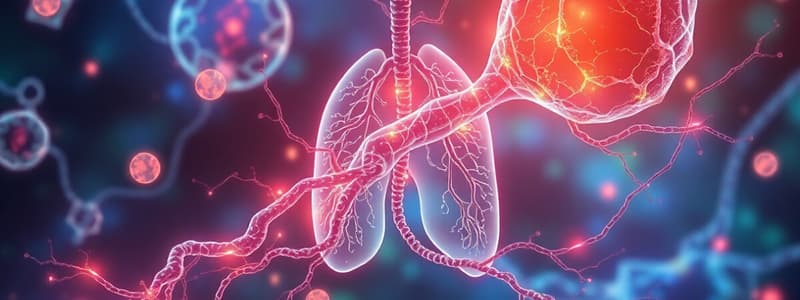Podcast
Questions and Answers
What is the primary product of glycolysis?
What is the primary product of glycolysis?
- 2 acetyl-CoA
- 4 ATP
- 2 pyruvate molecules (correct)
- 2 NADH
In which cellular location does the citric acid cycle occur?
In which cellular location does the citric acid cycle occur?
- Mitochondrial matrix (correct)
- Cytoplasm
- Outer mitochondrial membrane
- Inner mitochondrial membrane
What is the final electron acceptor in the electron transport chain?
What is the final electron acceptor in the electron transport chain?
- Oxygen (correct)
- Acetyl-CoA
- NADH
- FADH₂
Which stage of cellular aerobic respiration does not require oxygen?
Which stage of cellular aerobic respiration does not require oxygen?
What is the total net yield of ATP from one molecule of glucose during the entire aerobic respiration process?
What is the total net yield of ATP from one molecule of glucose during the entire aerobic respiration process?
Which of the following best describes the role of ATP synthase during oxidative phosphorylation?
Which of the following best describes the role of ATP synthase during oxidative phosphorylation?
Which process occurs directly after pyruvate oxidation in cellular respiration?
Which process occurs directly after pyruvate oxidation in cellular respiration?
How many carbon dioxide molecules are released during the complete oxidation of one glucose molecule?
How many carbon dioxide molecules are released during the complete oxidation of one glucose molecule?
What is the main function of ATP synthase in cellular respiration?
What is the main function of ATP synthase in cellular respiration?
During which stage of aerobic respiration is water produced as a byproduct?
During which stage of aerobic respiration is water produced as a byproduct?
What is the primary reason for the formation of heat during aerobic respiration?
What is the primary reason for the formation of heat during aerobic respiration?
Which substance is commonly used to demonstrate CO₂ liberation in aerobic respiration?
Which substance is commonly used to demonstrate CO₂ liberation in aerobic respiration?
How many ATP molecules are typically produced from one glucose molecule during aerobic respiration?
How many ATP molecules are typically produced from one glucose molecule during aerobic respiration?
What is the role of dehydrogenases in cellular respiration?
What is the role of dehydrogenases in cellular respiration?
What type of reaction is the breakdown of glucose during aerobic respiration?
What type of reaction is the breakdown of glucose during aerobic respiration?
What happens to the majority of energy produced from glucose during aerobic respiration?
What happens to the majority of energy produced from glucose during aerobic respiration?
Flashcards
Cellular Aerobic Respiration
Cellular Aerobic Respiration
A process that converts energy from nutrients, like glucose, into ATP (energy for cells). It needs oxygen and happens inside the mitochondria.
Glycolysis
Glycolysis
The first step in cellular respiration. Breaks down glucose into pyruvate, producing small amounts of ATP and NADH.
Pyruvate Oxidation
Pyruvate Oxidation
Converts pyruvate (from glycolysis) into acetyl-CoA, releasing CO2 and creating NADH, a crucial energy carrier.
Citric Acid Cycle
Citric Acid Cycle
Signup and view all the flashcards
Electron Transport Chain
Electron Transport Chain
Signup and view all the flashcards
Oxidative Phosphorylation
Oxidative Phosphorylation
Signup and view all the flashcards
Mitochondria
Mitochondria
Signup and view all the flashcards
ATP (Adenosine Triphosphate)
ATP (Adenosine Triphosphate)
Signup and view all the flashcards
ATP Synthase
ATP Synthase
Signup and view all the flashcards
Aerobic Respiration
Aerobic Respiration
Signup and view all the flashcards
Proton Gradient
Proton Gradient
Signup and view all the flashcards
Byproduct of Aerobic Respiration
Byproduct of Aerobic Respiration
Signup and view all the flashcards
Dehydrogenase
Dehydrogenase
Signup and view all the flashcards
ATP
ATP
Signup and view all the flashcards
36-38 ATP per glucose
36-38 ATP per glucose
Signup and view all the flashcards
Study Notes
Cellular Aerobic Respiration
- Cellular aerobic respiration is a metabolic process where cells convert biochemical energy from nutrients (like glucose) into adenosine triphosphate (ATP).
- This process uses oxygen in the mitochondria of eukaryotic cells.
- Aerobic respiration is vital for producing the majority of ATP required for survival.
Stages of Aerobic Respiration
1. Glycolysis
- Location: Cytoplasm of the cell.
- Process: Glucose (a six-carbon molecule) is broken down into two pyruvate molecules (three carbons each).
- Products: 2 ATP (net), 2 NADH, and 2 pyruvate molecules.
- Oxygen Requirement: Anaerobic (does not require oxygen).
- Significance: The first step in both aerobic and anaerobic respiration.
2. Pyruvate Oxidation
- Location: Mitochondrial matrix (in eukaryotes).
- Process: Each pyruvate is converted into acetyl-CoA, releasing one molecule of carbon dioxide per pyruvate.
- Products: 2 CO2, 2 NADH, and 2 acetyl-CoA (one from each pyruvate).
- Oxygen Requirement: Aerobic (requires oxygen).
3. Citric Acid Cycle (Krebs Cycle)
- Location: Mitochondrial matrix.
- Process: Acetyl-CoA combines to oxaloacetate to form citrate, reacting to produce energy-rich molecules.
- Products: 2 ATP, 6 NADH, 2 FADH2, and 4 CO2 (for each glucose molecule).
- Oxygen Requirement: Aerobic (requires oxygen).
4. Electron Transport Chain (ETC) and Oxidative Phosphorylation
- Location: Inner mitochondrial membrane.
- Process: Electrons from NADH and FADH2 pass through protein complexes. Energy is released to pump protons across the membrane, creating a proton gradient. This gradient drives ATP synthesis.
- Products: Approximately 32-34 ATP molecules and water (from oxygen accepting electrons and protons).
- Oxygen Requirement: Requires oxygen as the final electron acceptor.
1. Proton Gradient
- Protons in the intermembrane space possess potential energy as they move back into the matrix.
- Analogy: Potential energy of water behind a dam.
2. ATP Synthase
- Facilitates proton flow.
- Analogy: A turbine in the dam.
3. Flowing Protons
- Proton flow through the channel of ATP synthase is like water flowing through a water wheel.
4. ATP production
- Mechanical energy produced by ATP synthase is used to create ATP.
- Analogy: Water wheel turning a generator to create electricity.
Summary of ATP Yield
- Approximately 36-38 ATP per glucose molecule under ideal conditions in eukaryotic cells.
Practical Part
- The practical part involves various experiments to confirm the process:
- Water Condensation: Water is a byproduct of aerobic respiration (ETC and Oxidative phosphorylation)
- CO2 Liberation: Barium hydroxide reacts with CO2 to form barium carbonate (a visible precipitate).
- Heat Production: Breaking down glucose (exergonic) partially releases energy as ATP, remainder lost as heat.
- Dehydrogenase activity: Enzymes catalyze oxidation reactions; hydrogen atoms from glucose are transferred to electron acceptors (NAD+). An indicator detects the transfer of hydrogen.
Studying That Suits You
Use AI to generate personalized quizzes and flashcards to suit your learning preferences.




